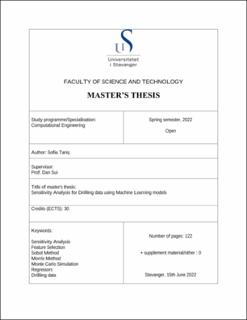| dc.description.abstract | Over the last decade, machine learning models have become highly popular. Without requiring significant human participation, Machine Learning models improve the efficiency and dependability of any system. Machine Learning models like Random Forest and Gradient
Booster can attain 99.9% accuracy. Despite all of the advantages of Machine Learning models, it remains a black box. Sensitivity Analysis is one method for deciphering the behavior of Machine Learning models. Sensitivity Analysis is used to study the influence of input parameters on the targeted outputs. Sensitivity Analysis methods were used to find the most influential input parameters in this thesis. A drilling dataset of the Volve field located in the North sea was used as a test case. The rate of penetration was selected as the output parameter and Sensitivity Analysis methods were implemented to analyze which input parameters have the most effect on the output.Feature Selection is a pre-processing approach used in Machine Learning models, but it was also used to predict crucial input parameters and compare with Sensitivity Analysis methods.Four Machine Learning, Random Forest, Gradient Booster, K-Nearest Neighbours, and Local Cascade Ensemble models were implemented with high accuracy and low Root Mean Square error values. These Machine Learning models were combined with methods for feature selection and sensitivity analysis. Recursive Feature Elimination, Pearson's correlation, Mutual
Information, Feature Importance utilizing Random Forest, and Permutation were among the five feature selection methods used. Two statistical methods, the Sobol and Morris method and Monte Carlo simulation, were used for sensitivity analysis. In total, seventeen methods were implemented when combined with four Machine Learning models. By selecting the most essential input parameters and deleting those that were unnecessary, it was possible to reduce the size of the dataset by half using these strategies. The outcomes of all three sensitivity analysis approaches were the same, however, the results of each feature selection method were different. For pre-processing the data, feature selection methods can be coupled with sensitivity analysis, however, they are not efficient enough for sensitivity analysis. The Morris approach was the most efficient and computationally inexpensive method. It can produce accurate results even with small sample size. | |
